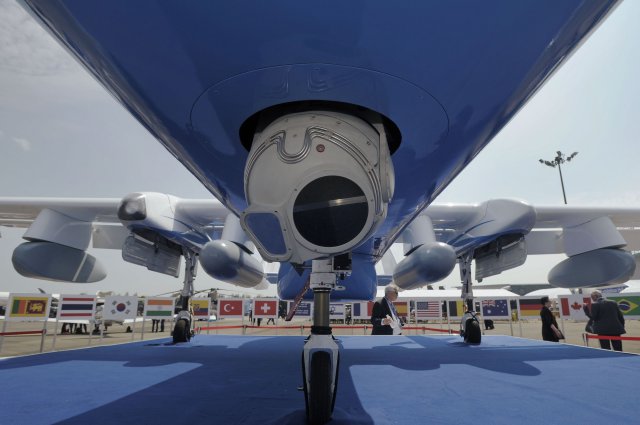U.S. manufacturers including General Atomics, which makes the Predator, can only sell to a few countries because of tight export restrictions. The controls give rival UAS makers from countries such as Israel and China a chance to win more business in the growing global market for unmanned aircraft systems, which one group forecasts to more than double in the next decade.
U.S. arms makers have been lobbying the government for several years to loosen the restrictions so they can sell their systems to more countries. They fear their established market is shrinking as domestic defence spending is squeezed and the U.S. military withdraws from Iraq and Afghanistan.
American aerospace companies are showing off the latest missiles, attack helicopters and fighter jets at the Singapore Airshow but they may find foreign rivals have the upper hand in cutting more deals for unmanned aircraft systems.
“There are countries like Israel and China that have weapons-capable aircraft and they can sell, so it definitely hampers us with business not just in this region but around the world because we cannot compete,” said Billy Gililland, President of Systems Integration at General Atomics Aeronautical Systems Inc.
The company’s Predator and Reaper are among the world’s most widely deployed UAS. They can loiter in the air for long periods to give their operators more time to verify targets before firing precision-guided warheads.
Exports of UAS are tightly controlled by an agreement signed by members of a group called the Missile Technology Control Regime, which includes the United States, Britain, Canada, France, Germany, Italy, and Japan. The group has since expanded to 34 countries but Israel and China aren’t members. The 1987 agreement was originally intended to curb the spread of ballistic missiles. Present day concern about spreading advanced weaponised UAS technology to countries or groups hostile to the U.S. is a factor in keeping the American restrictions in place.
Officials at companies such as Northrop Grumman, which makes the high-altitude Global Hawk, argue the restrictions hurt competitiveness in a market that Teal Group Co. forecasts to expand to $11.6 billion in 2023 from $5.2 billion last year. Israeli UAS manufacturers including Elbit Systems Ltd. and Israel Aviation Industries Ltd., or IAI, had big displays at the Singapore Airshow.
IAI unveiled its Super Heron, an upgraded version of its popular Heron. The company has sold UAS to 20 countries including Brazil and Turkey.
Israel has overtaken the U.S. as the world’s largest exporter of unmanned aircraft systems, selling $4.6 billion worth from 2005 to 2012, according to a report by consulting firm Frost & Sullivan. In the same period, U.S. overseas sales amounted to $2-$3 billion.
Asia is a growing market for IAI, said Sharly Ben Chetrit, its Executive Vice-President of Marketing, He said Israel also has its own restrictions on exports.
“I can assure you that we are adhering to the most strict licensing policy in Israel. I don’t think we have it easier,” he said.
China’s state-owned companies have developed dozens of UAS, including the Wing Loong, or Pterodactyl, which bears a striking resemblance to the Predator. A scale-model was on display at the airshow’s Chinese booth, where a salesman said it could carry two air-to-ground missiles weighing a combined 100 kilograms.
“It not only has strike capability but can be used for reconnaissance. America also has this type of UAS,” he said. He declined to give his name or say how much it cost. Staff said no officials were available to be interviewed.
“China is positioning itself so that any country on the planet that, for political or financial reasons, is restricted from purchasing American or allied UAS will be able to go to Beijing and get a comparable platform,” said Ian Easton, a research fellow at the 2049 Project Institute security think tank. He co-authored a recent report on China’s UAS.
China’s $139 billion defence budget last year was the world’s second biggest, accounting for about 9 percent of global military spending, according to a report last week by IHS Jane’s. It’s leading a broader rise in regional military spending, with Australia, India and South Korea also hiking budgets that’s widens opportunities for defence contractors.
To compete for export business, General Atomics launched a model last year called the Predator XP that can’t be armed. Gililland said his company has been pitching for business to countries “all over the Pacific Rim.” Only Britain, Holland and Italy have been allowed to buy the missile-ready version, the latter two only recently.
The XP has had a lukewarm reception because foreign militaries want the version that can carry out an airstrike.
The list price for a Predator XP system, including three aircraft, three ground stations and spare parts, is about $50-$60 million. So far only the United Arab Emirates has bought it. A Predator that can carry weapons is “substantially” more expensive, Gililland said, though he declined to give a figure.
On Tuesday, the airshow’s first day, Gililland met the chief of Saudi Arabia’s Air Force, who said because of the curbs the country would buy the Wing Loong made by a Chinese state-owned company. Chinese media reports say it has been exported to countries in the Middle East and Asia at a fraction of the Predator’s price.
Gililland said he hoped buyers would become more interested in the XP but the company would need to sell them on its surveillance capabilities.
“There’s a lot of ways that we can sell the XP but we have to get past everyone’s desire to have a U.S. Air Force, U.S. Army-style Predator that shoots Hellfire missiles.”
A total of $32 billion worth of commercial deals were announced during the six-day trade portion of the show, the event’s organizers said on Friday.
Photo: Israel Aviation Industries Ltd. Super Heron HF on display at the Singapore Airshow. -Joseph Nair / Associated Press
Source: Herald Net

